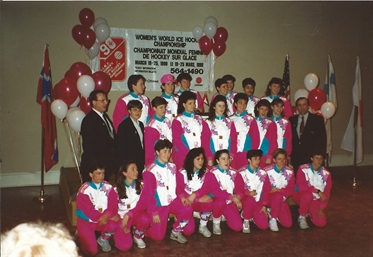CAN 1990: Sue Scherer
CAN 1990: Sue Scherer
“1990 was the coming of age”

 Team Canada’s group photo from 1990. Scherer is in the bottom row, third from the left.
Team Canada’s group photo from 1990. Scherer is in the bottom row, third from the left.
“I grew up in a hockey family in southwestern Ontario,” she explained. “My dad played semi-pro and was manager of the Kitchener Rangers. I had six brothers who all played, and our lives revolved around hockey. We lived in a small town, and in the sixties a lot of rural areas had girls’ teams, so I started playing when I was ten. At the time, there were teams in Tavistock, New Hamburg, St. Marys, and Fergus—all small towns in Ontario. I was on New Hamburg, but the kids on the team ranged in age from 10 to 18. Most of the teams were like that. The only ice they’d give us for practice was Friday night after the Junior C game. Of course I also played road hockey.”
Her childhood in hockey hardly ends there. “I’ve coached since I was 13. I started with a pee wee boys’ house-league team, and I’m still coaching. I now have a daughter playing Bantam AA and another playing pee wee, and the opportunities to play at levels, and the growth of girl’s and women’s hockey in the country has been phenomenal. And I think 1990 was the coming of age of women's hockey. That seemed to light the spark in the development of the game.”
Ah, yes, 1990. The year of pink sweaters, Geraldine Heaney’s memorable goal, TSN’s pioneering broadcast of the gold-medal game, the IIHF’s involvement in women’s hockey. “1990 took the lid off,” Scherer emphasized. “It was the first time a game was nationally televised. The City of Ottawa made the event happen and supported it. It spurred the next generation to want to play. I think it was also a turning point from the generation before. It made a difference for those who couldn’t play the game from previous years and decades because there was nothing there for them. It was that juxtaposition between the past and the future that we did something special.”
Continue readingIndeed, Canada’s roster was a perfect blend of old and new. Scherer was part of that old guard as was the legendary Shirley Cameron, 37 years old at the time but a hero from coast to coast.
“Shirley’s reputation was well established,” Scherer enthused. “She was a phenomenal athlete, a phenomenal leader and had exceptional talent. She could handle the puck, shoot the puck. She had an unspoken authority that was well understood and respected by everybody. I know there have been many people who have put her name forward for the Hockey Hall of Fame for a number of years, which I whole-heartedly support.”
And the future of the game was also heralded in in 1990. Angela James and Heaney had careers which took them to the IIHF Hall of Fame. France St. Louis, Margot Verlaan-Page, Vicky Sunohara, and Laura Schuler all had careers that lasted most of the rest of the decade, one in which Canada lost only one game, the 1998 Olympics finals.
“The exceptional talent we had on that team, even by today’s standards, is under-stated,” Scherer enthused. “Some went on to play for many years. But the bottom line was that we had a chance to play our best players against the best from other countries, and for an athlete that’s a dream come true.”
Scherer loved hockey from the time she was a kid and made it a part of her life even though there was no sign it would be more than just a hobby, a weekend passion to share with friends and a small group of devotees.
“When I was 13, my dad started the Kingston Canadians franchise,” she continued, “and they had one of the great women’s hockey teams in the country at the time, the Kingston Red Barons. At 14, I was the youngest player on that team, with Kim Ferguson. The rest were senior-level players. There were some players on those teams who would have been considered the best of the era, so it was a stroke of luck for me to be there. I also played at Queen’s University, and many of the Red Barons also went to Queen’s, so I practiced with them as well. One of my brothers was a goaltender, so I also practiced with him.”
In her late teens, hockey still in her life but a Women’s World Championships still many dreamy years in the future, Scherer packed her bags and went to school in Hamilton, Ontario. “I went to McMaster University for two years in a social-work program, and I played varsity there where there was another dynasty, the Hamilton Golden Hawks. I really lucked out in the places I landed in, playing with the quality players I did. Many of the players on “Mac” also played for the Golden Hawks. After two years, the athletic director at the University of Guelph asked me to transfer and become player-coach. I switched schools, and stayed for two years to complete my Bachelor of Arts degree, and then I stayed on for three more seasons as a coach.”
Despite enjoying her time behind the bench, Scherer, a two-sport athlete, still had too much competitive fire in her to give up playing at a high and ambitious level.
“At the same time I was in Guelph, I was on the national women’s softball team, and I was offered the coaching position of the national women’s team in softball in New Zealand, so I went there for a year, but it was way too far away from family, no hockey. Ball was really my priority because I played internationally, played at a couple of Pan-Am Games and World Championships. I retired from competitive ball in 1987, which was about the same time there was an announcement Canada was putting together a team for the World Championship. I decided to attend the open tryouts, and the rest went from there.”
Of course she made the team and went to Ottawa, but like the others she had no idea whether this tournament was a once in a lifetime opportunity or the start of something bigger. “Having played at the world stage in softball, I knew at some point that a Women’s World Championship was going to become a reality,” she suggested. “The question was, in 1990, was this the moment? I think we all hoped it would be. We hoped we were part of something bigger than just this one championship.”
It was. Although the IIHF committed to hosting future women’s events, the players themselves were pro-active, realizing they had to be aggressive if they wanted to improve, grow the game, and turn 1990 into “something bigger,” as Scherer described.
“Out of that tournament I think there were a number of players who ended up coming to Canada to play,” she noted. “As well, myself and three other players from Guelph were invited to Japan to run a hockey school there, which was a first. We were there for a month. We had a chance to meet a lot of players, young and old, from Japan.”
Professionally, Scherer has remained involved in sports, from her days of coaching and playing, to currently when she has a family and busy life most people would marvel at.
“When I got back from New Zealand, I worked with one of my brothers. He has one of the largest GM dealerships in southwestern Ontario, so I started a leasing company for him. I managed this for seven or eight years and then managed the dealership, but I missed being in sport, so I left to take a job at the Sport and Recreation Centre in Toronto doing gender equity and became a senior consultant. From there, I moved to London, Ontario, and became the assistant general manager to the senior manager of sport and athlete services for the Canada Games.
"Out of that," she continued, "I got a bug for Games. I became the Director of Games for Commonwealth Games Canada, and I managed the Canadian delegation for the Commonwealth Games in Manchester in 2002. I’ve been with Sport Canada since 2005 as the senior program officer. I started out in major games and hosting and was working for the government at major events—Olympics, Paralympics, Commonwealth Games, North American Indigenous Games, Canada Games—and about a year ago I switched to the Sport Development unit doing more program work with national sports organizations. It’s been 25 years now and I love it—and I’m still coaching!”
As life turned out for Scherer, she played only one more WW event, in 1992, but that was hardly the last sport heard from her.
“After 1992, I was 35 and had put a lot on hold for hockey and softball. I had started working in sport a few years earlier. It was time. I continued to play until 1996 and still play at the masters level competitively in Ottawa. I wanted to coach. I had two daughters. I was working major events, which seriously restricted the amount of time I had for training at the elite level.”
More telling is that virtually all of the players from Canada’s 1990 roster have remained in the game, playing with friends, coaching and raising children who play the game, developing a new generation of players.
“We all have busy lives, but we all got together at the 2007 Worlds in Winnipeg, which was an awesome opportunity,” Scherer said. “We were a pretty special and unique group of women. That was a very good hockey team. I see Kim Ratushny all the time; she coaches the same club I do. She also has a young daughter. Many of the players are coaching kids, so we run into each other at the rink.”
Back to Overview
















































